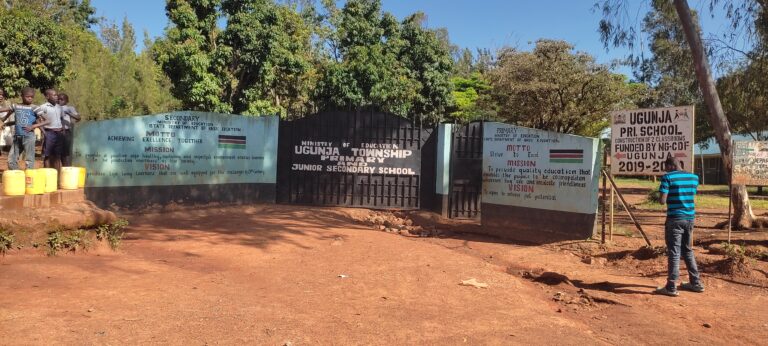Kijiji Yeetu Community Network with ISOC Kenya
Internet Society Kenya Chapter will deploy a community network project called Kijiji Yeetu Community Network in the Ugunja community in Siaya county.

Project status: Closed
Country: Kenya
Partner: Internet Society Kenya Chapter
Impact goal: 5 Schools (Sirandumb School, Ambira School, Ngunya School, Ugunga School, Nyamasare School), 1 Community Health Centre, 1 Community Resource Centre, 2 Public Internet hotspots in Unga and Ambira shopping centres, Train 50 net wardens (30 female and 20 Male youths), Train 50 elderly people on meaningful internet consumption and basic digital literacy.
About the project
The Kijiji Yeetu Community Network project, led by the Internet Society Kenya Chapter, aims to provide low-cost and secure connectivity to underserved communities in Ugunja, Kenya. The project's goal is to bridge the digital divide and enable residents to access vital government services, educational resources, and business opportunities. It involves the installation of community network nodes in public schools, institutions, and health centers. The project also includes training local community members as net wardens to maintain and manage the network.
Results
The project in Ugunja, Siaya County, has significantly improved internet connectivity and digital literacy in underserved communities. Through network assessments and capacity-building initiatives, the project has addressed internet service inconsistencies and low ICT skill levels among teachers and community members. The deployment of community network nodes and strategic partnerships with organizations like Liquid Telecom and Google Taara have improved internet access and affordability, advancing digital inclusion and education transformation.
Continuous monitoring and evaluation have provided valuable insights into project performance, despite high costs and resource constraints. The project's success is evident in schools participating in the Digital Rampage program, where students use gadgets for learning and administrative efficiency.
1. KijiTech Network Assessment and Footprint:
- A comprehensive techno-feasibility survey and assessment were conducted in Ugunja, Siaya County, revealing crucial insights into community needs and challenges.
- The project implementation plan was meticulously developed based on the survey findings, outlining specific activities, timelines, and resource allocations.
- ICT gap analyses highlighted internet service inconsistencies and low ICT skill levels among teachers and community members, emphasizing the need for comprehensive ICT integration.
- Despite challenges, the elevation of the mast height and the expansion to a 33-meter mast significantly improved signal strength and coverage, enhancing user experience.
- Continuous reviews and assessments in January 2024 further refined the project plan, addressing digital literacy gaps and ICT infrastructure deficiencies.
2. KijiTech Capacity-building:
- Two capacity-building sessions for community members and government officials fostered collaboration, trust, and support from important stakeholders.
- Net warden training sessions equipped participants with technical skills to maintain, manage, and troubleshoot the network, promoting sustainability and community empowerment.
- Practical learning experiences, such as deployment simulations and troubleshooting exercises, highlighted the transformative power of technology in education and community development.
3. Scaling Network Deployment and Implementation:
- Collaboration with Liquid Telecom and Google Taara facilitated the deployment of community network nodes, significantly improving internet connectivity in underserved communities.
- The expansion of internet access to additional schools and strategic partnerships with organizations like the Association of Community Networks further advanced digital inclusion and education transformation.
- Comprehensive line-of-sight studies and the deployment of advanced wireless optical communication technology paved the way for enhanced internet access and community empowerment.
4. Network Monitoring and Process Maintenance:
- Continuous monitoring and evaluation of project performance revealed insights into ICT infrastructure, digital literacy, and community engagement.
- Feedback mechanisms highlighted the transformative impact of connectivity services, despite challenges such as high costs and resource constraints.
- Remarkable progress was reported in schools participating in the Digital Rampage program, with students utilizing gadgets for learning and administrative efficiency improving through internet connectivity at the Ambira chief office.
- Collaborative partnerships with Google Taara and Liquid Telecom demonstrated the potential for cost-effective internet solutions, emphasizing the importance of bridging the digital divide through collaborative efforts.
Challenges
The project also faced challenges throughout its implementation, which affected various aspects of the initiative.
One significant hurdle was the inadequacy of ICT facilities and trained personnel in schools, impeding efforts to integrate digital technologies into education effectively. This challenge highlighted the need for comprehensive capacity-building programs to equip teachers and students with the necessary skills to leverage technology for learning effectively.
Financial constraints posed another significant challenge, with high infrastructure costs and inflation rates impacting the project's budget and resource allocation. These financial limitations restricted the project's ability to scale and deploy internet infrastructure efficiently, requiring careful planning and prioritization of initiatives to maximize impact within the available resources.
Technical obstacles, such as line-of-sight issues and tree obstructions, also hampered network deployment efforts, leading to delays and inefficiencies in connectivity provision. Overcoming these technical challenges required innovative solutions and local expertise to navigate and resolve obstacles effectively.
Additionally, slow internet speeds and inconsistent service reliability posed ongoing challenges, limiting the project's ability to provide reliable and high-speed internet access to underserved communities. Addressing these issues necessitated ongoing monitoring and optimization of network infrastructure to enhance performance and user experience.
Despite these challenges, the project remained committed to overcoming obstacles and advancing its goals of promoting digital inclusion and community empowerment.
About the partner
ISOC Kenya Chapter is an affiliate organization of the Global Internet Society. They work hand in hand to support the vision of the Internet Society by supporting and promoting the development of the internet as a global technical infrastructure, a resource to enrich people's lives and a force for good in society. Their work aligns with their goals for the Internet to be open, globally connected, secure, and trustworthy. You can read more about them on their website!